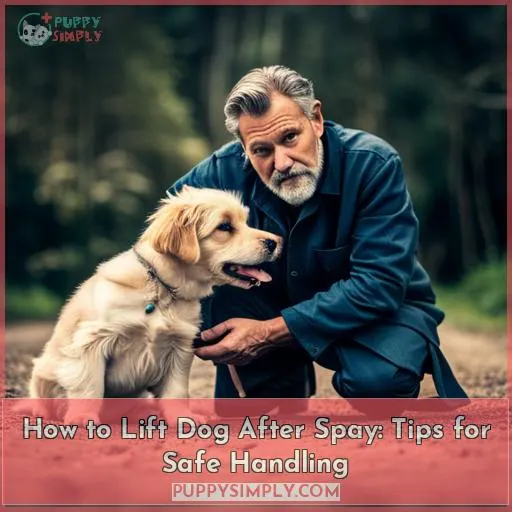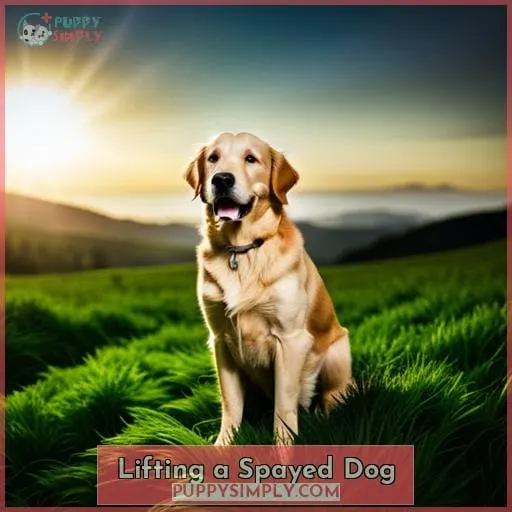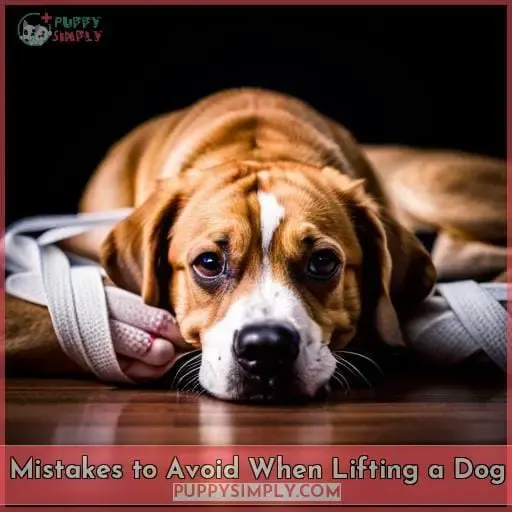This site is supported by our readers. We may earn a commission, at no cost to you, if you purchase through links.
After your dog’s spay surgery, lifting them safely is essential for healing.
Support their entire body, avoiding pressure on the incision area.
For smaller dogs, scoop them up with one arm under their chest and the other under their hindquarters.
For larger breeds, kneel down and slide one arm under their chest while using your other arm to support their rear end.
Avoid mishandling or letting them jump.
By learning proper techniques, you’ll minimize discomfort and prevent complications during their recovery period.
With patience and care, they’ll be back to their energetic self soon – just be sure to follow your vet’s instructions carefully.
Table Of Contents
Key Takeaways
- Proper lifting techniques are important to avoid complications and injuries after a dog has been spayed.
- Avoid lifting by the collar, scruff, tail, or underarms/legs to prevent pressure on the incision and potential infections.
- Small dogs can be lifted gently from underneath their front legs while supporting the hind legs with one hand.
- Larger dogs should be lifted using both hands, one supporting each side of the body above waist level.
Lifting a Spayed Dog
When caring for a recently spayed pup, it’s essential to remember that pressure on any incision can cause complications and infections. So, avoid lifting your furry friend by their collar, scruff, tail, or underarms/legs.
For small dogs like a caretaker of a 10-pound Yorkie, you may lift the pup gently from underneath its front legs while supporting the hind legs with one hand. Whereas larger pups should be lifted using both hands, one supporting each side of its body above waist level until you are able to get an arm around them securely in order to support their weight better.
It is important not only to consider how you’re lifting but also what they are being supported on after being lifted – ideally nothing hard such as furniture or steps but rather something soft like an orthopedic dog bed that will cushion some of the impact when they land onto it, even if this means carrying them up and down stairs instead!
Pet owners should also give stretching exercises and massage therapy for short periods daily during recovery, which helps keep muscles flexible without placing too much strain on joints that may have been weakened due to lack of exercise during recuperation time.
The most important thing is patience, allowing enough rest between walks where possible, while adhering strictly to exercise guidelines set out by veterinary professionals post-surgery.
Finally, provide plenty of mental stimulation through playtime activities at home in place of long walks outdoors – this way, your pet remains happy throughout recovery without risking further injury and infection caused by unnecessary movement after spaying.
Alternatives to Lifting a Large Spayed Dog
Rather than lifting your large pup after being spayed, there are other ways to get them from one place to another.
- Create a multi-level home environment with ramps for easy access so they can climb up and down without needing assistance.
- Keep their incision site clean by investing in soft donut collars or surgical bodysuits instead of the traditional cone of shame, which could rub against stitches removal sites or wound areas, causing further discomfort.
- Consider walking them like a martini glass where they extend out on either side of you while standing still, allowing your pup to move freely forward as if it were moving through water without having to be lifted at all! This not only reduces strain on their body but also helps reduce stress since dogs naturally want movement when feeling anxious or confined – something that often occurs during post-op care when exercise restrictions must be enforced.
By keeping these tips in mind, we can ensure our furry friends have a smooth recovery experience while avoiding any unnecessary risks along the way!
Different Lifting Techniques for Small and Large Dogs
Your pup’s post-op care is important, so be sure to use the right lifting techniques for their size during recovery. Lifting a spayed or neutered dog should always be done carefully as pressure on an incision can lead to complications and infection.
Before attempting any lift, it’s best to assess the situation. If your pup is in pain or uncomfortable, then you may need assistance from another person.
Smaller pups are generally lifted with two hands gently supporting them around their body near chest level. Larger dogs should have one hand each at both sides of their ribcage just behind the front legs when being picked up off the ground.
To avoid potential issues like behavioral problems due to mental stress associated with handling pain areas, it’s recommended that owners provide alternative ways, such as ramps, instead of carrying large dogs upstairs.
Providing safe havens on ground levels where they can rest comfortably without having access to stairs is also beneficial. Walking them like a martini glass will help reduce strain and stress, as movement helps release anxiety.
Paying attention to incision site cleanliness using donut collars and bodysuits, rather than traditional cone-shaped headwear, will prevent rubbing against stitches removal sites, causing discomfort too!
Lastly, but most importantly, it’s imperative to contact the vet immediately if signs of illness occur amidst the healing process.
Mistakes to Avoid When Lifting a Dog
Be sure to steer clear of common mistakes when picking up your pup after they’ve been spayed – don’t take any chances and play it safe!
It’s important to avoid pressure on the incision, as this can lead to complications or infections. Also, be aware that lifting a dog in pain can bring about behavioral issues, so make sure you use the right technique for their size.
Smaller pups should be gently supported around their body near chest level with two hands; larger dogs should have one hand each at both sides just behind the front legs when being picked up off the ground.
To further reduce stress levels while handling a large spayed dog, consider alternatives such as ramps instead of carrying them upstairs and providing ground-level sanctuaries instead of climbing stairs unless necessary.
Furthermore, never lift by collar or scruffs/tails – not only is it dangerous but also uncomfortable for your pet! Restrict car rides too – walking will allow them more control over their movements than driving will provide.
Finally, consult with your veterinarian immediately if signs of illness appear during recovery time so they may suggest the best solutions suited specifically for your pup’s needs.
What Can I Do to Prevent Injury?
It’s essential to take the utmost care when lifting a dog after they have been spayed in order to avoid pressure on the incision and potential complications. Knowing how to lift your pup safely, taking into account their size and behavior, is key.
Be sure not to use collars, scruffs/tails, or underarms/legs as this can be dangerous for them. Additionally, it’s important to understand that behavioral issues may arise if your pet is in pain while being lifted.
Avoiding Pressure on the Incision
You should take care to ensure that your pup is not subjected to any pressure on the incision during their recovery, as this can lead to potentially serious complications. To reduce matting and keep them comfortable, consider using grooming wipes or a sanitary trim.
Alternatives such as donut collars, recovery collars, surgical bodysuits, and even an Elizabethan collar are all better suited than traditional pet parent methods of lifting their dog after the neutering procedure.
Safe Lifting Techniques
Carrying your pup after a spay can be tricky, so make sure you use the correct technique for their size and age. Minimizing pressure on the dog’s incision is key – gently hold them close to your body while supporting their actual legs.
Pain management, along with proper restraint, will help keep them safe and comfortable during transport or when providing exercise in the home, such as going up/down stairs or getting into/out of furniture.
Encouraging gentle walking instead of car rides is another effective method that helps minimize potential risks associated with lifting a large pup off the ground – opt for cozy ground-level havens like beds and couches whenever possible! With these tips in mind, you’ll ensure that your furry friend gets around without putting any unnecessary strain on their recently neutered body.
Behavioral Issues
It’s important to monitor the pup for any behavioral changes during recovery, as neutering can lead to temporary aggression or anxiety. Minimizing pain and providing post-operative care are key, starting with exercise restrictions.
Separation anxiety may arise if sudden lifestyle changes occur; mental exercises like walks in the neighborhood help keep pups relaxed.
Dangers of Lifting by Collar, Scruff, Tail, or Underarms/Legs
Avoiding the temptation to lift your pup by its collar, scruff, tail, or underarms/legs can help prevent complications in up to 70% of recently spayed dogs. Minimizing pressure on the incision and avoiding risky lifts is key; instead, look for behavioral cues that indicate a safe way of lifting them.
Alternatives such as using a sling may be necessary for larger canines; consult with your vet about what’s ideal for their meal plan and procedure post-spay.
Can a Dog Be Carried After Being Neutered?
When it comes to caring for a neutered pup, you should be mindful of the need to protect any incision and minimize pressure. A dog can’t be carried after being spayed as this can create too much strain on their body, which could lead to a more painful infection or even worse.
It’s important that during the days of recovery, your pup’s movement is minimized to allow healing time for their wound.
One way you can help minimize movement is by providing activity restrictions. This includes no car rides, jumping off furniture, or climbing stairs until cleared by a vet consultation following surgery.
Grooming tips are also highly recommended before and after spaying to reduce matting during recovery. Avoid excessive brushing, as it may open up stitches if they haven’t been removed yet. Consider using grooming wipes instead. Additionally, make sure not to use alternate methods like cone-of-shame alternatives (e.
g., soft donut collars) unless otherwise directed by your veterinarian. These may cause discomfort when lifting them up, like a wet sack of potatoes. Always look out for red flags such as bleeding from the incision site or increased lethargy/disinterest.
Lastly, separation anxiety could arise from sleeping downstairs. Try making an orthopedic bed available on the ground level, along with other forms of mental exercise (e.g., walks around the neighborhood rather than driving). Following these guidelines will help ensure both you and your pup have a safe recovery process post-spay without worrying about potential complications down the line.
Frequently Asked Questions (FAQs)
How long should I wait before lifting my dog after a spay?
After a spay, it’s best to wait at least two weeks before lifting your pup. Give them time to heal and stay off their feet as much as possible; use blankets or slings if needed. Create an environment where they feel safe and secure, so they can focus on recovery without having to worry about being lifted too soon.
What is the best way to safely lift a spayed dog?
Gently scoop up your spayed pup in your arms, like a baby. Make sure to keep the incision clear and avoid applying any pressure on it.
How can I tell if my dog is in pain after being spayed?
Pay attention to your spayed dog’s behavior and energy levels. Look for signs of pain such as limping, reluctance to move, and whimpering. If you notice any discomfort or other changes in behavior, consult your vet right away.
Are there any activities that I should avoid with a spayed dog?
Avoid strenuous activities and excessive jumping with your spayed dog. Monitor their behavior for signs of pain and provide a soft, orthopedic bed to sleep on. Encourage calm walks rather than running or playing fetch, as these can cause strain to the incision site.
Restrict car rides, climbing stairs, and furniture hopping until they have fully recovered from surgery.
What should I do if my spayed dog needs to go up or down stairs?
If your spayed dog needs to go up or down stairs, use caution. Lift them carefully with a supportive arm beneath their chest and another supporting the back legs. If possible, avoid these activities; if not, gently guide your pup’s feet one stair at a time for added support and safety.
Conclusion
Your pet’s health is paramount, and lifting them after they’ve been spayed is not something to be taken lightly. It’s essential to use the right technique and be aware of the risks involved so you can ensure your pet’s safety.
Symbolically speaking, think of your dog as a delicate flower that needs to be carefully nurtured and protected. Be gentle with them and be aware of the potential hazards that come with lifting.
With the right precautions in place, you can ensure your pet’s safety and well-being.













